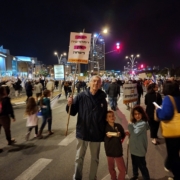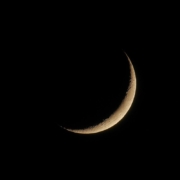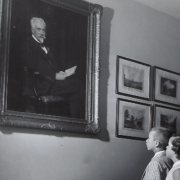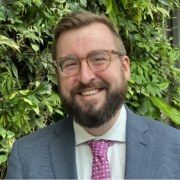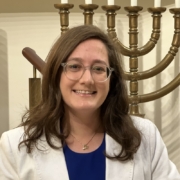Remembering Our Temple Leadership
Two Past Presidents were laid to rest last week. Before each funeral service, an Honour Guard of Past Presidents stood on either side of the casket, as is our custom. Holy Blossom Temple was strengthened by their leadership. May their memories continue to be for blessing.
 Richard Lorie z”l
Richard Lorie z”l
From the Temple Archives, thanks to Sheila Smolkin:
Richard served as President of Holy Blossom Temple from 1978 to 1980. In his address to the congregation at the Annual General Meeting, Nov. 4, 1979, Richard quoted from his Installation address: “We must use the experiences and traditions of the past, the lay leadership and professional staff of the present to build a strong congregation of the future.”
In addition to welcoming Cantor Maissner to the congregation, Richard’s first year as President saw Jacques Barruch and Morris Vigoda take over as co-chairmen of the Usher Committee, the creation of a new committee to help Vietnamese Boat People resettle in Canada, and an Interfaith trip to Israel and Egypt led by Rabbi Fields and Rev. Stanford Lucyk of Timothy Eaton Memorial Church. Richard also supported Henrietta Chesnie z”l in her role as Chair of the Local Arrangements Committee for the UAHC Biennial held in Toronto that year.
A year later, Richard reported in his address to the Annual General Meeting that he had been pleased to welcome Rabbi Steve Garten as Holy Blossom’s new Director of Education and Rabbi Joan Friedman, as Assistant Rabbi, the first woman to hold a rabbinic position in a Canadian congregation.
A memory about Richard’s leadership from Michael Cole:
When Dick Lorie became president of Holy Blossom, he decided that he should know more about Judaism than he remembered from his days in Holy Blossom’s Religious School. So, he enrolled in a lot of Temple’s adult education classes, including Hebrew, and borrowed a lot of books from the Sisterhood library. By the end of his term as President — and beyond –, Dick had become quite Jewishly knowledgeable.
I was on the Temple Board when Dick was President. I remember him as unfailingly fair, patient, polite, and decent. May his memory be for blessing!
An excerpt from Rabbi Splansky’s eulogy:
I didn’t know until now that Richard was a Levi. It makes perfect sense. The Levites were the ones who carried the Tabernacle on their shoulders and took care of Jerusalem’s Temple. Richard was reliable. You could count on him. If Richard Lorie said he’s going to do something, he’d do it. He’d do it well and he’d do it right. If he said he’s going to be there, he’d be there — right on time, or more likely, a little early. This is more than a good habit. This is at the heart of the character of the man that he was. We learn about this trait in this week’s parasha. Ki Tissa literally means, “When you lift. When you elevate.” Like his Levite ancestors, Richard learned that by dedicating himself to lifting up his family and his community, he would, in turn, be uplifted himself.
Jean recalls: “He was determined to do the right thing.” When I asked her how Richard came into Temple leadership, she said, “Well he couldn’t sit still during services, so he became an Usher. And one thing led to another.”
I like to imagine it began earlier than that. Perhaps on Richard’s Bar Mitzvah day, right here at Holy Blossom Temple in 1942. In the midst of WWII, on this very sanctuary, on this very bima, Richard read from the Torah and got a hint of what it feels like to stand in the midst of the community, to be needed. Heinz Warshauer, his teacher and mentor, and set high standards for him. Camp Arowhon made Richard Head of Sail, the most trustworthy role on camp. He went on to become President of Holy Blossom Temple, President of Oakdale Country Club, President of the Toronto Construction Association, on the Board of the JCC, and President of their condo building for many years. Richard’s long-time friend and fellow congregant, Walter Pape, said of Richard: “When kids are little they dream of being a fireman or an astronaut. Little Dicky Lorie said, ‘When I grow up, I want to be a President.’”
 Richard Krelstein z”l
Richard Krelstein z”l
From the Temple Archives, thanks to Sheila Smolkin:
At the conclusion of Richard Krelstein’s term as President (1988-1990), Rabbi Marmur wrote an article for the Bulletin in which he expressed the following hope “that although he and I came from very different corners of the Jewish world, we would walk in the same direction. My hope has been fulfilled. In the process of working together, I have got to know him and to appreciate his many lovable qualities, of least his kindness and his sense of humour.”
During his term as President, the Leo Baeck Day School made a decision to open a southern campus at Holy Blossom and Mel Olsberg retired as Executive Director of the congregation.
When addressing the congregation, Richard said: “I believe that people have an obligation to provide skills to the community in which they live. The reward is in the satisfaction derived at seeing the results of your involvement.”
A memory about Richard’s leadership from Avra Rosen:
Richard first introduced himself to me by email in November 2019 to congratulate me on becoming the President of Holy Blossom Temple. Under our bylaws, our Past Presidents and Wardens are members of the Presidents Council. I was looking for two representatives from The Council to sit on the new Board of Directors. Richard thanked me for the invitation, but advised that as he was living in Los Angeles, he would not “be in a position to accept the honour.” Five months later, deep into lockdown, Richard reached out to ask how he could help.
The pandemic was a gift to Richard in terms of reconnecting with Holy Blossom and working with our lay leadership to ensure congregational success and stability. Richard was suddenly able to actively participate in the Presidents Council Zoom meetings, participate in our services online, and see the breadth of our online programs. Richard was convinced, and I wholly agreed, that our live stream services were one of the best in North America. He was very determined to see how we could further welcome non-member guests from outside of the GTA. He often sent me links to Google analytics and other synagogues. Thanks to his persistence, I invited him to join a taskforce on communications and he was an avid participant, sending us countless suggestions. Even as we began to emerge from COVID, Richard continued to advise me.
I was expecting to be in Los Angeles in November for Rabbi Sharon Sobel’s installation at Temple Beth Sholom. Richard suggested we get together for coffee so we could finally meet in person. Sadly, personal circumstances prevented me from travelling then and we never shared that cup of coffee. I will always be grateful for Richard’s support. It was my privilege to stand as an Honour Guard beside his casket at his funeral in the Main Sanctuary last week.
An excerpt from Rabbi Splansky’s eulogy:
Although Richard was known for running a very disciplined, 59-minute Board Meeting, he was also known for crying at every funeral — even if he didn’t know the person who had died. Sydney says: “If you need a crier, Richard would be there.”
Our Biblical Books of the Prophets contain many references to professional criers. It was considered to be an art form – moirology. And moirologists like Richard Krelstein, were held in high esteem, for they could tap into some truth about the meaning of life and death that others could not. Perhaps Richard acquired this rare wisdom at a young age. He was just 11 when his mother died. Away from home – at boarding school during the year and at camp during the summers — young Richard must have had time to reflect on the themes of life and death in ways that no child should have to. If Richard were sitting today in this sanctuary, which he loved, no doubt he would be crying – over how much he loved his wife and children, over how much he loved his friends, over how much he loved simply being alive, but not one of his tears would be shed like Rabbi Assi’s tears. According to Midrash Tanhuma, Rabbi Assi lamented at the end of his life that he shirked his responsibilities to lead the community. If Richard Krelstein were sitting today in this sanctuary he loved, he would also smile with confidence in knowing that whenever the opportunity to lead, to mentor, to volunteer, to serve and strengthen the community, he rose to the occasion – with a full heart and without hesitation.
When I asked Sydney how Richard, from Memphis, Tennesse, came to be in leadership at Holy Blossom, she explained, “He started on the House Committee, and worked his way up the ladder. They must have seen a spark in him. And… he adored Rabbi Plaut. He loved to study Torah and philosophy with him.” She reflected back and said, “It was a new start for him. His strength came from Holy Blossom Temple.”

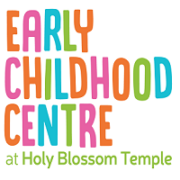

 Richard Lorie z”l
Richard Lorie z”l Richard Krelstein z”l
Richard Krelstein z”l

